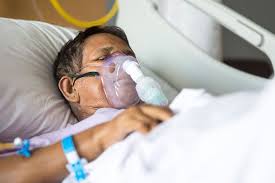Steroids, IV vitamin C, and heparin — experimental early intervention protocol treating Covid-19
A number of critical care doctors at different hospitals in the U.S. have created a working group and a protocol they say is reducing the need for mechanical ventilation and controlling the mortality rate of covid-19.
Although this protocol has not yet been validated in a randomized, controlled trial, this group of doctors has formed an association called the Frontline COVID-19 Working Group (FLCC).
 The protocol is published on their website — called the MATH+ COVID19 Early Treatment Protocol — and includes intravenous corticosteroid methylprednisolone, high-dose ascorbic acid (vitamin C), the anticoagulant drug heparin, plus “optional treatment components” including thiamine, vitamin D, and zinc.
The protocol is published on their website — called the MATH+ COVID19 Early Treatment Protocol — and includes intravenous corticosteroid methylprednisolone, high-dose ascorbic acid (vitamin C), the anticoagulant drug heparin, plus “optional treatment components” including thiamine, vitamin D, and zinc.
As described on their website, “The components of MATH+ are off-patent, inexpensive, and globally available.” Learn more about the MATH+ protocol here.
FLCC emphasizes that only when the protocol is started within six hours of presenting to the ER will the need for mechanical ventilators and ICU beds decrease significantly.
In the press release on the FLCC website, they write, “… it is the severe inflammation sparked by the Coronavirus, not the virus itself, that kills patients. The hyper-inflammation triggered by COVID-19, also known as “cytokine storm” requires use of corticosteroids to prevent deterioration into a very severe form of Acute Respiratory Distress Syndrome (ARDS), a condition which causes the lungs to fail. Further, the inflammation appears to cause high rates of blood clotting in multiple organs necessitating the use of blood thinners.
Corticosteroids, often known as steroids, are anti-inflammatory medicines prescribed for a wide range of conditions, ranging from asthma and atopic eczema, and they have also been used to treat underlying conditions that lead to ARDS, associated with acute covid-19.
When to start treatment, dosing, and for how long should these powerful drugs be used are just some of the questions that are currently being examined in regard to using steroids to treat ARDS. Read more here. Regarding treating covid-19, published studies on the use of corticosteroids in treating sepsis are inconclusive.
A preliminary single-center experience in China showed that in patients with severe covid-19 pneumonia, early, low-dose, and short-term application of corticosteroid was associated with faster improvement of clinical symptoms and lung improvement.
However, a subsequent two-site study indicates that there is no benefit to steroid treatment and in fact, can delay virus clearance.
Both studies have a small sample size, and both recommend additional studies. The journal Critical Care Explorations published a commentary (April 2020) that concludes, “Although there is a wide divergence of opinion in the literature on whether corticosteroids should be used in patients with Covid-19, the two largest studies on H1N1 and SARS lend support to its use.” Read more here.
Regarding vitamin C, as reported in the journal Annals of Intensive Care, “Vitamin C is best known for its antioxidant properties, being able to scavenge damaging reactive oxygen species, thus protecting the body’s cells and tissues from oxidative damage and dysfunction. However, the vitamin also has numerous other important functions within the body, many of which are known to support healthy immune function. During infection, vitamin C levels can become depleted and a person’s requirement for vitamin C increases with the severity of the infection, and in severe cases, may require intravenous administration of gram doses in order to achieve high enough levels in the body to compensate for the enhanced turnover of the vitamin.”
There are ongoing trials, including in two in China, assessing whether for those infected with COVID-19, infusion of mega-doses of vitamin C can reduce complications from ARDS associated with COVID-19. One study is just started in Wuhan to ascertain if infusion of vitamin C can improve the prognosis of patients with severe acute respiratory infection (SARI). The study began on February 14, and will complete September 30.
Dr. Paul E. Marik, Chief of the Division of Pulmonary & Critical Care Medicine at the Eastern Virginia Medical School, Norfolk, and member of the FLCCC, describes the intravenous infusion of vitamin C’s role in the protocol as having a “synergistic effect” when combined with corticosteroids. Dr. Marik is the author of a 2018 paper in the journal Nutrients that discuss this therapy, (along with thiamine), as a treatment strategy in the management of patients with severe sepsis and septic shock. Dr. Marik notes that “multiple randomized controlled trials are currently underway to test this hypothesis.”
Regarding low-molecular-weight heparin: clinicians treating COVID-19 patients have described a worrisome prevalence of blood clots in patients. Acutely ill patients with severe viral pneumonia and ARDS have a 23-times increased risk for pulmonary embolism. An observational study from Brazil shows that the systematic use of heparin for treating severe covid-19 improves oxygen levels and overall outcomes.
The World Health Organization (WHO) in March 2020 released “A Coordinated Global Research Roadmap: 2019 Novel Coronavirus.” The first research priority objective is to “define the natural history of COVID-19 infection.” The second objective is to “determine interventions that improve the clinical outcome of COVID-19 infected patients.” The FLCC notes on their Facebook page that, “For the very first time, the WHO has stated that corticosteroids and vitamin C — two of the key components of the MATH+ Protocol warrant “further reviews.”
The FLCC reports that member hospitals using the early intervention protocol detail that patients entering the ER with shortness of breath who are started on the MATH+ protocol within six hours do not deteriorate to the point of needing to be put on a ventilator in the ICU.
On the website, there is a disclaimer on the protocol that states, “NOTE: The opinions expressed in this release do not necessarily represent the official positions of any institutions with which the quoted physicians are affiliated.”
Don’t try this at home!
Dr. Teresa Lightfoot, DVM warns, “The major concern with this protocol is timing. If the patient is experiencing a cytokine storm, this makes sense.
What’s worrisome is people using methylprednisone or other steroids at home. This will suppress their initial immune response to the virus. Likewise, people on heparin, or warfarin, as the dosage of blood thinners for existing conditions should not be increased without medical supervision. The chances of cranial or other bleeds could be significant.”
One of the questions that need to be answered about this treatment includes what are the long-term outcomes for these patients?
I will follow this story and report back as more information becomes available.
__________________________
Food, Nutrition, and Your Health columnist Susan Burke March moved to Cuenca after 35 years as a Registered and Licensed Dietitian and Certified Diabetes Educator in the United States. She currently serves as the Country Representative from Ecuador for the Academy of Nutrition and Dietetics.
Susan helps people attain better weight and health, and reduce the risk of heart disease, diabetes, and other conditions that can be improved with smart lifestyle modifications.
Susan is offering “Free” 20-minute consultations for just a $15 donation to one of the important foundations here in Cuenca. It’s a perfect time to address issues such as cooking at home, strategies for weight loss, or boosting your immunity by improving your diet.
Contact her at SusantheDietitian@gmail.com




















